Amana ART348FFFB, ART318FFDB, MRT519SFFW, ART308FFDW, MRT519SFFZ Owner's Manual
...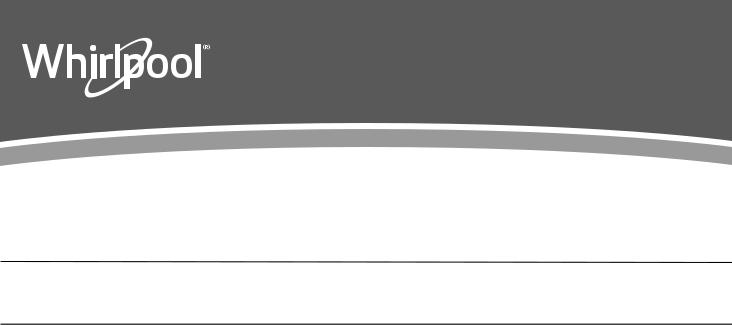
REFRIGERATOR
USER INSTRUCTIONS
THANK YOU for purchasing this high-quality product. Register your new refrigerator at www.whirlpool.com. In Canada, register your refrigerator at www.whirlpool.ca.
For future reference, please make a note of your product model and serial numbers. These can be located on the inside wall of the refrigerator compartment.
Model Number___________________________________________ |
Serial Number____________________________________________ |
Para obtener acceso a “Instrucciones para el usuario del refrigerador” en español, o para obtener información adicional acerca de su producto, visite: www.whirlpool.com.
Necesitará su número de modelo y de serie, ubicado en el interior del compartimiento del refrigerador.
TABLE OF CONTENTS / TABLE DES MATIÈRES
REFRIGERATOR SAFETY.............................................................. |
2 |
Proper Disposal of Your Old Refrigerator..................................... |
3 |
INSTALLATION INSTRUCTIONS................................................... |
3 |
Unpack the Refrigerator............................................................... |
3 |
Location Requirements................................................................. |
4 |
Electrical Requirements................................................................ |
4 |
Water Supply Requirements......................................................... |
4 |
Connect the Water Supply |
|
(on some models)........................................................... |
5 |
Refrigerator Doors........................................................................ |
6 |
Reversibility Kit Instructions....................................................... |
12 |
Adjust the Doors......................................................................... |
12 |
REFRIGERATOR USE................................................................... |
13 |
Using the Controls...................................................................... |
13 |
REFRIGERATOR FEATURES....................................................... |
14 |
Refrigerator Shelves................................................................... |
14 |
Deli Drawer.................................................................................. |
14 |
Crisper......................................................................................... |
14 |
FREEZER FEATURES................................................................... |
15 |
Freezer Shelf............................................................................... |
15 |
DOOR FEATURES......................................................................... |
15 |
Door Rails.................................................................................... |
15 |
Door Bins.................................................................................... |
15 |
Utility Compartment.................................................................... |
16 |
Ice Maker.................................................................................... |
16 |
REFRIGERATOR CARE................................................................ |
16 |
Cleaning...................................................................................... |
16 |
Changing the Light Bulb............................................................. |
17 |
Vacation and Moving Care......................................................... |
17 |
TROUBLESHOOTING................................................................... |
18 |
Refrigerator Operation................................................................ |
18 |
Temperature and Moisture.......................................................... |
19 |
Ice and Water.............................................................................. |
19 |
ACCESSORIES.............................................................................. |
19 |
WARRANTY................................................................................... |
20 |
BRAND BADGE PLACEMENT TEMPLATE............. |
BACK COVER |
SÉCURITÉ DU RÉFRIGÉRATEUR............................................... |
|
21 |
Mise au rebut du vieux réfrigérateur........................................... |
|
23 |
INSTRUCTIONS D’INSTALLATION............................................. |
|
23 |
Déballage du réfrigérateur.......................................................... |
|
23 |
Exigences d’emplacement......................................................... |
|
24 |
Spécifications électriques........................................................... |
|
24 |
Spécifications de l’alimentation en eau...................................... |
24 |
|
Raccordement à la canalisation d’eau |
|
|
(sur certains modèles)................................................................. |
|
25 |
Portes du réfrigérateur................................................................ |
|
26 |
Instructions pour l’ensemble d’inversion du sens d’ouverture..32 |
||
Ajustement des portes................................................................ |
|
32 |
UTILISATION DU RÉFRIGÉRATEUR........................................... |
|
33 |
Utilisation des commandes........................................................ |
|
33 |
CARACTÉRISTIQUES DU RÉFRIGÉRATEUR............................ |
34 |
|
Tablettes du réfrigérateur............................................................ |
|
34 |
Bac pour spécialités alimentaires............................................... |
|
34 |
Tiroir à légumes.......................................................................... |
|
34 |
CARACTÉRISTIQUES DU CONGÉLATEUR............................... |
35 |
|
Tablette de congélateur.............................................................. |
|
35 |
CARACTÉRISTIQUES DE LA PORTE......................................... |
|
35 |
Tringles dans la porte.................................................................. |
|
35 |
Balconnets de porte................................................................... |
|
36 |
Compartiment utilitaire............................................................... |
|
36 |
Machine à glaçons...................................................................... |
|
36 |
ENTRETIEN DU RÉFRIGÉRATEUR............................................. |
|
37 |
Nettoyage.................................................................................... |
|
37 |
Remplacer l’ampoule d’éclairage............................................... |
|
37 |
Précautions à prendre pour les vacances ou |
|
|
le déménagement....................................................................... |
|
38 |
DÉPANNAGE................................................................................. |
|
39 |
Fonctionnement du réfrigérateur................................................ |
|
39 |
Température et humidité............................................................. |
|
40 |
Glaçons et eau............................................................................ |
|
40 |
ACCESSOIRES.............................................................................. |
|
41 |
GARANTIE..................................................................................... |
|
42 |
GABARIT DE POSITIONNEMENT |
|
|
DE L’INSIGNE DE LA MARQUE............. |
COUVERTURE ARRIÈRE |
|
W11224768A
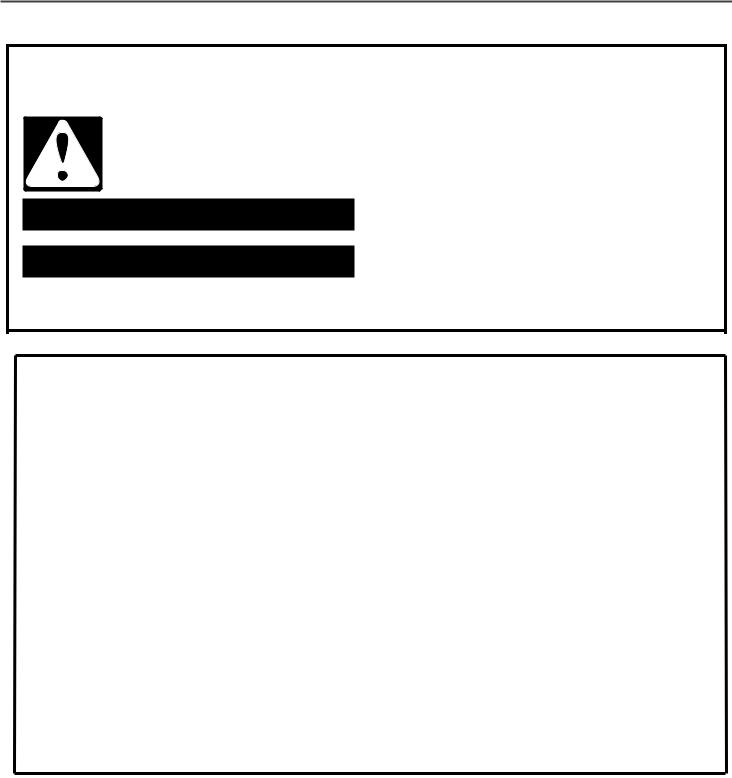
REFRIGERATOR SAFETY
Your safety and the safety of others are very important.
many important safety messages in this manual and on your appliance. Always read and obey all safety
safety alert symbol.
alerts you to potential hazards that can kill or hurt you and others.
messages will follow the safety alert symbol and either the word “DANGER” or “WARNING.”
mean:
 DANGER
DANGER  WARNING
WARNING
You can be killed or seriously injured if you don't immediately follow instructions.
You can be killed or seriously injured if you don't follow instructions.
All safety messages will tell you what the potential hazard is, tell you how to reduce the chance of injury, and tell you what can happen if the instructions are not followed.
IMPORTANT SAFETY INSTRUCTIONS
WARNING: To reduce the risk of fire, electric shock or injury to persons when using the refrigerator, follow basic precautions, including the following:
Plug into a grounded 3-prong outlet.
Do not remove the ground prong.
Do not use an adapter.
Do not use an extension cord.
Disconnect power before servicing.
Replace all parts and panels before operating.
Remove doors from your old refrigerator.
Connect only to the potable water supply.
Use non-flammable cleaner.
Keep flammable materials and vapors, such as gasoline, well away from the refrigerator.
Use two or more people to move and install the refrigerator.
Disconnect the power before installing the ice maker (on ice maker kit-ready models only).
Use a sturdy glass when dispensing ice (on some models).
Do not hit the refrigerator glass doors (on some models).
This appliance is not intended for use by persons (including children) with reduced physical, sensory or mental capabilities, or lack of experience and knowledge, unless they have been given supervision or instruction concerning use of the appliance by a person responsible for their safety.
Children should be supervised to ensure that they do not play with the appliance.
If the supply cord is damaged, it must be replaced by the manufacturer, its service agent or similarly qualified person in order to avoid a hazard.
Do not store explosive substances such as aerosol cans with a flammable propellant in this appliance.
This appliance is intended to be used in household and similar applications such as:
-Staff kitchen areas in shops, offices and other working environments;
-Farm houses and by clients in hotels, motels and other residential type environments;
-Bed and breakfast type environments;
-Catering and similar non-retail applications.
PLEASE KEEP THESE INSTRUCTIONS
2
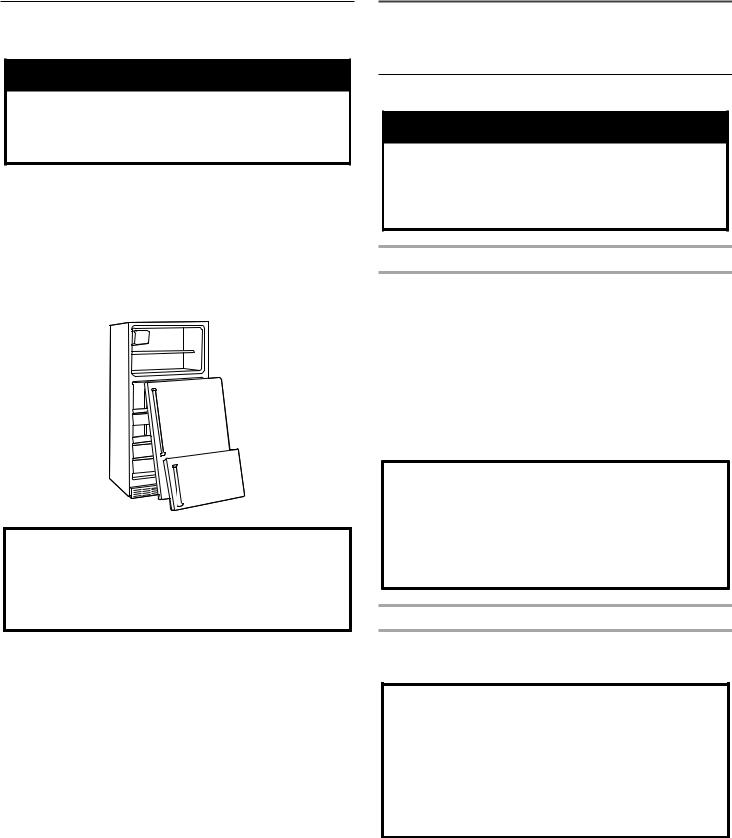
Proper Disposal of Your Old
Refrigerator
 WARNING
WARNING
Suffocation Hazard Remove doors from your old refrigerator.
Failure to do so can result in death or brain damage.
IMPORTANT: Child entrapment and suffocation are not problems of the past. Junked or abandoned refrigerators are still dangerous
– even if they will sit for “just a few days.” If you are getting rid of your old refrigerator, please follow these instructions to help prevent accidents.
Before You Throw Away Your Old Refrigerator or Freezer:
■■ Take off the doors.
■■ Leave the shelves in place so that children may not easily climb inside.
Important information to know about disposal of refrigerants:
Dispose of refrigerator in accordance with Federal and Local regulations. Refrigerants must be evacuated by a licensed, EPA certified refrigerant technician in accordance with established procedures.
INSTALLATION
INSTRUCTIONS
Unpack the Refrigerator
 WARNING
WARNING
Excessive Weight Hazard
Use two or more people to move and install refrigerator.
Failure to do so can result in back or other injury.
Remove the Packaging
IMPORTANT: Do not remove the white foam air return insert from behind the control panel on the ceiling of the refrigerator. If the insert is removed, ice may migrate down from the freezer and cause icicles to form.
■■ Remove tape and glue residue from surfaces before turning on the refrigerator. Rub a small amount of liquid dish soap over the adhesive with your fingers. Wipe with warm water and dry with a soft cloth.
■■ Do not use sharp instruments, rubbing alcohol, flammable fluids, or abrasive cleaners to remove tape or glue. These products can damage the surface of your refrigerator. For more information, see “Refrigerator Safety.”
When Moving Your Refrigerator:
Your refrigerator is heavy. When moving the refrigerator for cleaning or service, be sure to cover the oor with cardboard or hardboard to avoid oor damage. Always pull the refrigerator straight out when moving it. Do not wiggle or “walk” the refrigerator when trying to move it, as oor damage could occur.
Clean Before Using
After you remove all of the packaging materials, clean the inside of your refrigerator before using it. See the cleaning instructions in “Refrigerator Care.”
Important information to know about glass shelves and covers:
Do not clean glass shelves or covers with warm water when they are cold. Shelves and covers may break if exposed to sudden temperature changes or impact, such as bumping. Tempered glass is designed to shatter into many small, pebble-size pieces. This is normal. Glass shelves and covers are heavy. Use both hands when removing them to avoid dropping.
3
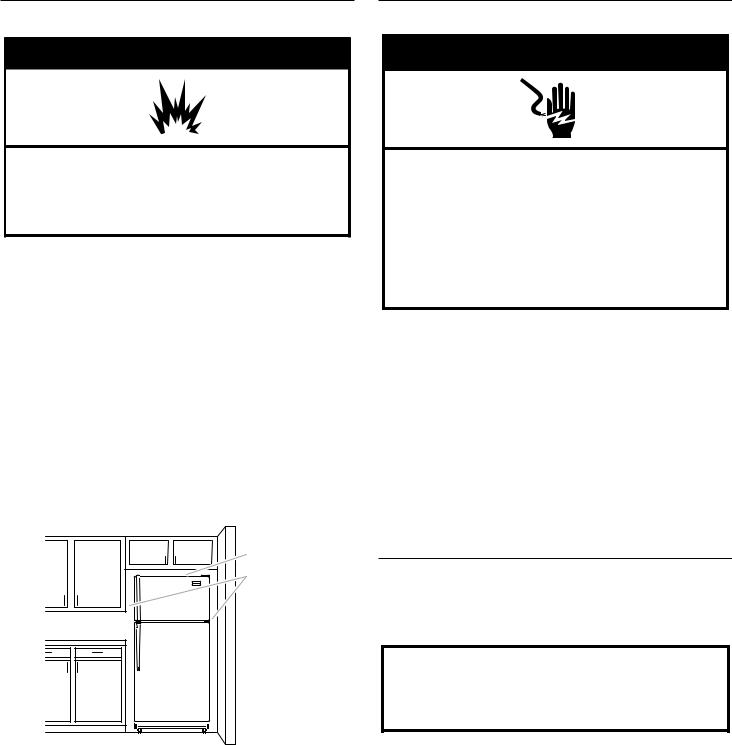
Location Requirements
 WARNING
WARNING
Explosion Hazard
Keep ammable materials and vapors, such as gasoline, away from refrigerator.
Failure to do so can result in death, explosion, or re.
IMPORTANT: This refrigerator is designed for indoor household use only.
To ensure proper ventilation for your refrigerator, it is recommended to allow a 1/2" (1.25 cm) space on each side. Allow 1½" (3.81 cm) of space between overhead cabinets and refrigerator top. Allow at least 1" (2.54 cm) between back of cabinet and the wall (consider the condenser as back in case is present). If your refrigerator has an ice maker, allow extra space at the back for the water line connections.
If you are installing your refrigerator next to a fixed wall, leave enough space on the hinge side to allow the door to swing open.
Level the refrigerator. See "Adjust the Doors" part of this manual.
NOTE: This refrigerator is intended for use in a location where the temperature ranges from a minimum of 55°F (13°C) to a maximum of 110°F (43°C). The preferred room temperature range for optimum performance, which reduces electricity usage and provides superior cooling, is between 60°F (15°C) and 90°F (32°C). It is recommended that you do not install the refrigerator near a heat source, such as an oven or radiator.
11/2" (3.81cm)
1/2" (1.25 cm)
Electrical Requirements
 WARNING
WARNING
Electrical Shock Hazard Plug into a grounded 3 prong outlet. Do not remove ground prong.
Do not use an adapter.
Do not use an extension cord.
Failure to follow these instructions can result in death, fire, or electrical shock.
Before you move your refrigerator into its final location, it is
important to make sure you have the proper electrical connection.
Recommended Grounding Method
A 115 volt, 60 Hz, AC only, 15 or 20 A fused, grounded electrical supply is required. It is recommended that a separate circuit serving only your refrigerator be provided. Use an outlet that cannot be turned off by a switch. Do not use an extension cord. NOTE: Before performing any type of installation or cleaning,
or removing a light bulb, turn cooling off or turn the control (Thermostat, Refrigerator, or Freezer control depending on the model) to OFF, and then disconnect the refrigerator from the electrical source. When you are finished, reconnect the refrigerator to the electrical source and turn cooling on or reset the control (Thermostat, Refrigerator, or Freezer control,
depending on the model) to the desired setting. See “Using the Controls” in the User Instructions, User Guide, or Use & Care Guide.
Water Supply Requirements
Read all directions before you begin.
IMPORTANT:
■■ Connect to potable water supply only.
Do not use with water that is microbiologically unsafe or of unknown quality without adequate disinfection before or after the system. Systems certified for cyst reduction may be used on disinfected waters that may contain filterable cysts.
■■ If you turn the refrigerator on before the water line is connected, turn the ice maker off.
■■ All installations must meet local plumbing code requirements.
■■ Use copper tubing and check for leaks. Install copper tubing only in areas where the household temperatures will remain above freezing.
TOOLS NEEDED: Flat-blade screwdriver, 7/16" and 1/2" openend wrenches or 2 adjustable wrenches, 1/4" nut driver and drill bit, cordless drill. Gather the required tools and parts before starting installation. Read and follow the instructions provided with any tools listed.
NOTE: Your refrigerator dealer has a kit available with a 1/4" (6.35 mm) saddle-type shutoff valve, a union, and copper tubing. Before purchasing, make sure a saddle-type valve complies with your local plumbing codes. Do not use a piercing-type or 3/16" (4.76 mm) saddle valve which reduces water flow and clogs more easily.
4
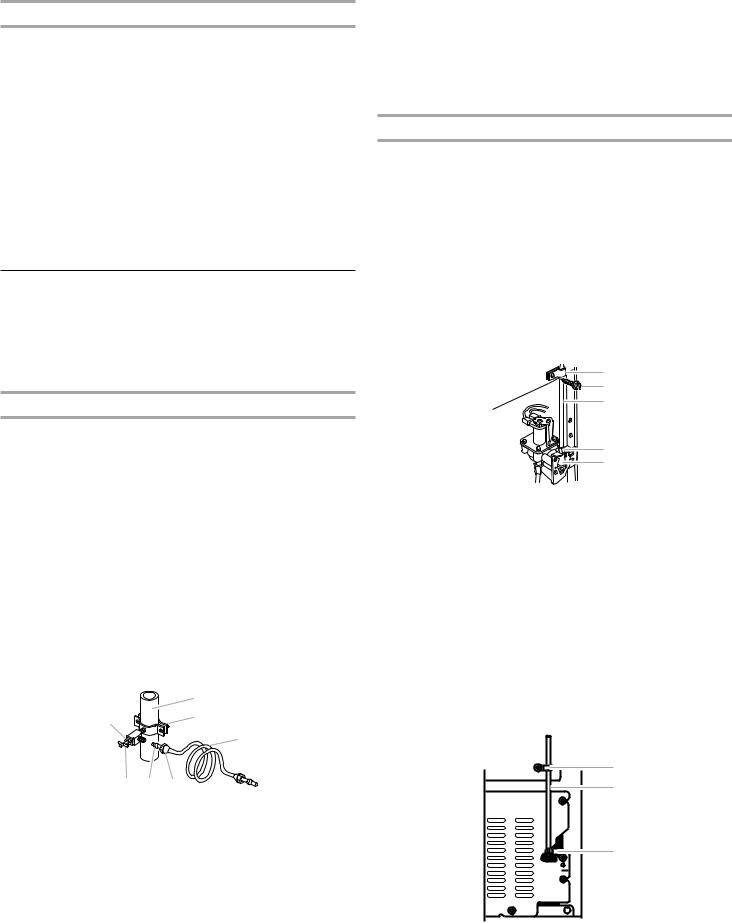
Water Pressure
A cold water supply with water pressure between 30 and 120 psi (207 and 827 kPa) is required to operate the ice maker. If you have questions about your water pressure, call a licensed, qualified plumber.
Reverse Osmosis Water Supply
If a reverse osmosis water filtration system is connected to your cold water supply, the water pressure to the reverse osmosis system needs to be a minimum of 40 to 60 psi (276 to 414 kPa).
If the ice maker is still not operating properly:
■■ Check to see whether the sediment filter in the reverse osmosis system is blocked. Replace the filter if necessary.
■■ Allow the storage tank on the reverse osmosis system to refill after heavy usage.
If you have questions about your water pressure, call a licensed, qualified plumber.
Connect the Water Supply
(on some models)
Read all directions before you begin.
IMPORTANT: If you turn the refrigerator on before the water line is connected, turn the ice maker off to avoid excessive noise or damage to the water valve.
Connect the Water Line
1.Unplug refrigerator or disconnect power.
2.Turn off main water supply. Turn on nearest faucet long enough to clear line of water.
3.Locate a 1/2" to 1¹⁄4" (1.27 cm to 3.18 cm) vertical cold water pipe near the refrigerator.
IMPORTANT:
■■ Make sure it is a cold water pipe.
■■ Horizontal pipe will work. Drill on the top side of the pipe, not the bottom. This will help keep water away from the drill and normal sediment from collecting in the valve.
4.Determine the length of copper tubing you will need. Measure from the connection on lower left rear of refrigerator to the water pipe. Add 7 ft (2.1 m) to allow for cleaning. Use 1/4" (6.35 mm) O.D. (outside diameter) copper tubing. Be sure both ends of copper tubing are cut square.
5.Using a cordless drill, drill a 1/4" hole in the cold water pipe you have selected.
|
A |
G |
B |
|
|
|
C |
F E |
D |
A. Cold water pipe |
E. Compression sleeve |
B. Pipe clamp |
F. Shutoff valve |
C. Copper tubing |
G. Packing nut |
D.Compression nut
6.Fasten the shutoff valve to the cold water pipe with the pipe clamp. Be sure the outlet end is solidly in the 1/4" drilled hole in the water pipe and that the washer is under the pipe clamp. Tighten the packing nut. Tighten the pipe clamp screws slowly and evenly so washer makes a watertight seal. Do not overtighten.
7.Slip the compression sleeve and compression nut on the copper tubing as shown. Insert the end of the tubing into the outlet end squarely as far as it will go. Screw compression nut onto outlet end with adjustable wrench. Do not overtighten.
8.Place the free end of the tubing in a container or sink, and turn on the main water supply. Flush the tubing until water is clear. Turn off the shutoff valve on the water pipe. Coil the copper tubing.
Connect to Refrigerator
NOTE: On kit models, attach water valve to refrigerator according to kit instructions.
Style 1
1.Unplug refrigerator or disconnect power.
2.Attach the copper tube to the valve inlet using a compression nut and sleeve as shown. Tighten the compression nut. Do not overtighten.
3.Use the tube clamp on the back of the refrigerator to secure the tubing to the refrigerator as shown. This will help avoid damage to the tubing when the refrigerator is pushed back against the wall.
4.Turn shutoff valve ON.
5.Check for leaks. Tighten any connections (including connections at the valve) or nuts that leak.
|
A |
|
B |
|
C |
|
D |
|
E |
A. Tube clamp |
D. Compression nut |
B. Tube clamp screw |
E. Valve inlet |
C.Copper tubing
6.The ice maker is equipped with a built-in water strainer. If your water conditions require a second water strainer, install it in the 1/4" (6.35 mm) water line at either tube connection. Obtain a water strainer from your nearest appliance dealer.
Style 2
1.Unplug refrigerator or disconnect power.
2.Disconnect the tube clamp on the back of the product and insert the copper tubing through the clamp as shown.
3.Attach the copper tube to the valve inlet using a compression nut and sleeve as shown.
4.Tighten the compression nut. Do not overtighten. Reattach the tube clamp and tube to the back of the cabinet.
A
B
C
A. Tube clamp |
C. Compression nut |
B. Copper tubing |
|
5

5.Turn shutoff valve ON. Check for leaks. Tighten any connections (including connections at the valve) or nuts that leak.
6.The ice maker is equipped with a built-in water strainer. If your water conditions require a second water strainer, install it in the 1/4" (6.35 mm) water line at either tube connection. Obtain a water strainer from your nearest appliance dealer.
Complete the Installation
 WARNING
WARNING
Electrical Shock Hazard Plug into a grounded 3 prong outlet. Do not remove ground prong.
Do not use an adapter.
Do not use an extension cord.
Failure to follow these instructions can result in death, fire, or electrical shock.
1. Plug into a grounded 3 prong outlet.
NOTE: Allow 24 hours to produce the first batch of ice. Discard the first three batches of ice produced. Allow 3 days to completely fill ice container.
Refrigerator Doors
Depending on the width of your doorway, you may need to remove the doors to move the refrigerator into your home. Also, the door hinges are factory installed on the right-hand side. If you want the door to open from the other direction, you must reverse the door swing.
IMPORTANT:
 WARNING
WARNING
Electrical Shock Hazard Disconnect power before removing doors.
Failure to do so can result in death or electrical shock.
■■ Before you begin, turn the refrigerator control off, unplug refrigerator or disconnect power. Remove food and any adjustable door or utility bins from doors.
■■ Depending on your model, your refrigerator has either Style 1 - Contour Doors or Style 2 - Standard Doors. Reference the graphic specific to your model later in this section following “Final Steps.”
NOTE: A Reversibility Kit, which includes a new Brand Badge and hole covers, is available.
Tools Needed: 5/16" hex-head socket wrench, #2 Phillips screwdriver, flat-b lade screwdriver, 5/16" open-end wrench, flat 2" putty knife
Remove Doors and Hinges
5⁄16" Hex-Head Hinge Screw
1.Unplug refrigerator or disconnect power.
2.Using a hex-head socket wrench, remove the three 5⁄16" hex-head hinge screws from the Top Hinge and lift up to remove the hinge. See Top Hinge graphic.
NOTE: Provide additional support for the doors while the hinges are being moved. Do not depend on the door magnets to hold the doors in place while you are working.
3.Lift the freezer door off of the center hinge and set it aside.
4.Remove the washer from the top of the Center Hinge pin.
 A
A
A.Washer
5.Using a hex-head socket wrench and an open-end wrench, remove the three screws from the Center Hinge and remove the hinge. Set aside.
A
B
A.Center hinge
B.5⁄16" hex-head hinge screws
6.Remove the washer from the bottom of the Center Hinge pin.
7.Lift the refrigerator door from the Bottom Hinge and set aside.
8.Using a hex-head socket wrench, remove the four 5⁄16" hex-head hinge screws from the Bottom Hinge and pull the hinge from the bottom of the refrigerator door.
6
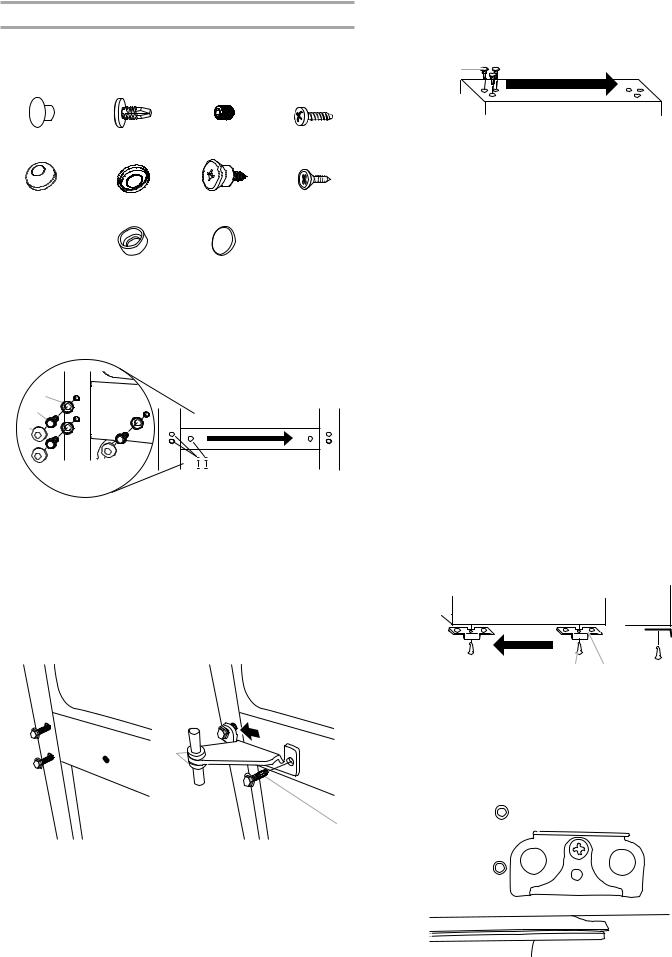
Reverse Doors and Hinges (optional)
IMPORTANT: If you want to reverse your doors so that they open in the opposite direction, follow these steps. If you are not reversing the doors, see “Replace Doors and Hinges.”
See complete graphics later in these instructions.
Door Hinge |
Cabinet Hinge |
Setscrew |
Door Stop |
Hole Plug |
Hole Plug |
|
Screw |
Dome Cap |
Dome Cap |
Shoulder |
Flat-Head |
|
Washer |
Screw |
Handle |
|
|
|
Screw |
|
Shoulder |
Door Handle |
|
|
Screw Washer |
Hole Cap |
|
Reverse Center Hinge
1.Remove the three dome caps and screws from the handle side and use them to fill the holes created when the hinge screws were removed.
A
B
C
A. Dome cap washers |
C. Dome caps |
B.Hex-head hinge screws
2.Using the three 5⁄16" hex-head hinge screws, removed in Step 1, insert two screws halfway into the holes, leaving space to insert the Center Hinge.
3.Once the refrigerator door is in place, slide the center hinge from the right onto the screws, insert the third screw, and then tighten all screws completely.
NOTE: Make sure the washers are in place on both the top and bottom pins of the center hinge.
A B
B
A
A.5⁄16" hex-head hinge screws
B.Washers
Reverse Freezer Door
1.Remove the three cabinet hole plugs from the top of the cabinet and place them in the hinge holes on the opposite side.
A
A.Cabinet hole plugs
2.Remove the door handles. See the model specific graphics later in these instructions.
Door Handles installed with flat-head screws and setscrews:
■■ Remove the two flat-head handle screws from the bottom
of the freezer door handle.
■■ Using the 1/8" hex key, loosen the setscrew attaching the top of the handle.
■■ Pull the handle away from the door to release it from the shoulder screw. Keep all parts together.
Door handles installed with flat-head screws only:
■■ Remove the screw cover and the three flat-head handle screws. Keep all parts together.
3.Using the plastic tool (provided), remove the brand badge from the freezer door by prying up the right-hand side and slowly peeling the badge away from the door, revealing the hole to mount the door handle.
NOTES:
■■ To avoid scratching the finish, do not use a sharp or metallic object to pry the brand badge from the door.
■■ Rub a small amount of liquid dish soap over any adhesive residue with your fingers. Rinse the door with warm water and dry with a soft cloth.
4.Depending on your model, remove the shoulder screw and its washer from the left-hand side of the door and fasten it into the hole that was behind the brand badge.
5.Remove the door stop from the bottom of the freezer door.
A B
A.Door stop screw
B.Door stop
6.Move the door stop to the opposite side making sure that the hole in the door stop plate is aligned perfectly with the hole for the center hinge pin.
7.Using the screw removed earlier, fasten the door stop to the bottom of the freezer door.
 A
A
A. Door stop screw
7
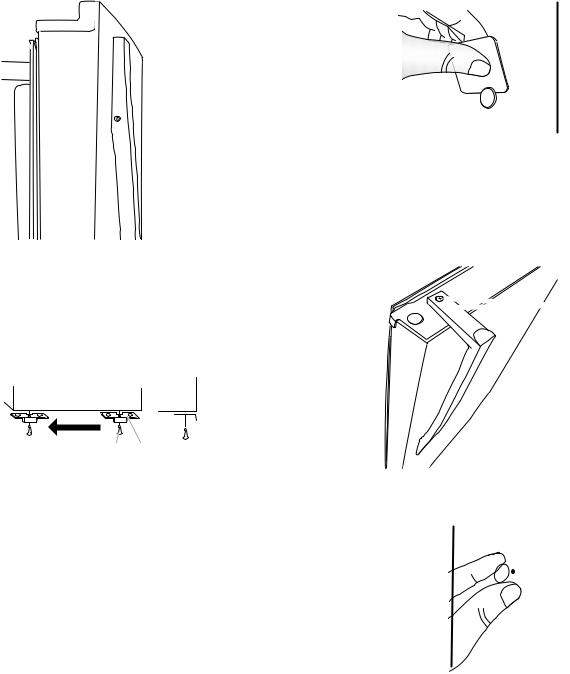
8.Depending on your model, place the handle on the shoulder screw and push the handle toward the door until the mounting base is flush against the door.
5.Remove the cap covering the hole on the opposite side of the door where the refrigerator door handle will be installed and discard the cap.
 A
A
A.Setscrew
9.Fasten the bottom of the handle to the bottom of the freezer door.
10.Tighten all screws. Set aside the freezer door until the hinges and refrigerator door are in place.
Reverse Refrigerator Door
1.Remove the door stop from the bottom of the refrigerator door.
A B
A.Door stop screw
B.Door stop
2.Replace the door stop on the opposite side of the refrigerator door, making sure that the hole in the door stop plate is aligned perfectly with the hole for the Bottom Hinge pin.
3.Fasten the door stop to the door.
4.Remove the door handles. See the model-specific graphics later in these instructions.
Door Handles installed with flat-head screws and setscrews:
■■ Remove the screws from the top of the refrigerator door
handle.
■■ Remove the setscrew from the lower part of the handle.
■■ Pull the handle away from the door to release it from the shoulder screw. Keep all parts together.
Door handles installed with flat-head screws only:
■■ Remove the screw cover and the three flat-head handle screws. Keep all parts together.
6.Depending on your model, remove the shoulder screw and its washer from the left-hand side of the door and fasten it into the hole that was behind the cap.
7.Depending on your model, place the handle on the shoulder screw and push the handle toward the door until the mounting base is flush against the door.
8.Fasten the top of the refrigerator handle to the top of the refrigerator door.
 A
A
A.Flat-head handle screws
9.Cover the remaining hole with the cap (provided).
10.Remove door hinge hole plug from the refrigerator door. Move to opposite side.
11.Tighten all screws. Set aside refrigerator door until bottom hinge is installed on the opposite side of the refrigerator.
8
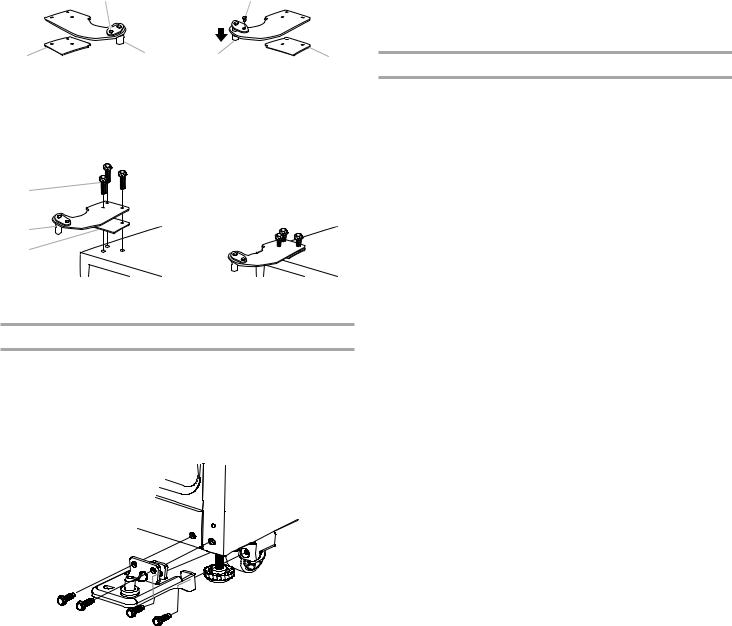
Reverse Top Hinge - Contour door models only
1.Remove the screw attaching the hinge pin to the hinge. Turn the hinge over so that it is pointing in the opposite direction.
2.Place the plastic spacer beneath the hinge so that it will be between the hinge and the cabinet, making sure the holes are aligned.
B |
|
|
B |
A |
C |
C |
A |
A. Plastic spacer |
|
C. Hinge pin |
|
B.Hinge pin screw
3.Fasten the Top Hinge to the opposite side of the cabinet, inserting the screws only halfway, so you will be able to replace and align the freezer door later.
A
B
C
A. 5⁄16" hex-head hinge screws C. Plastic spacer
B. Top hinge pin
Replace Doors and Hinges
IMPORTANT: Provide additional support for the doors while the hinges are being moved. Do not depend on the door magnets to hold the doors in place while you are working.
Install Refrigerator Door
1.Insert the hinge pin into the Bottom Hinge of the refrigerator door and fasten the hinge to the cabinet. Do not tighten completely.
A.Bottom hinge
2.Place the washer on top of the Bottom Hinge pin.
3.Place the refrigerator door onto the Bottom Hinge pin.
4.Measure the distance from the bottom of the refrigerator door to the floor. The distance should be approximately 14⁄5"
(4.6 cm).
NOTE: If necessary, loosen the Bottom Hinge, without removing the screws, adjust the door to the correct height and fully tighten the screws.
Install Freezer Door
1.Place washer on the upper hinge pin of the Center Hinge.
2.Place the freezer door on the upper hinge pin of the Center Hinge.
3.Insert the Top Hinge pin into the drilled hole in the top of the freezer door. Do not tighten the screws completely.
4.Align the doors so that the bottom of the freezer door aligns evenly with the top of the refrigerator door. Tighten all screws.
NOTE: The distance between the doors should be approximately 3/4" (19 mm).
Final Steps
1.Plug in the refrigerator or reconnect the power.
2.Reset the controls. See “Using the Controls.”
3.Return all removable door parts to doors and food to refrigerator.
9
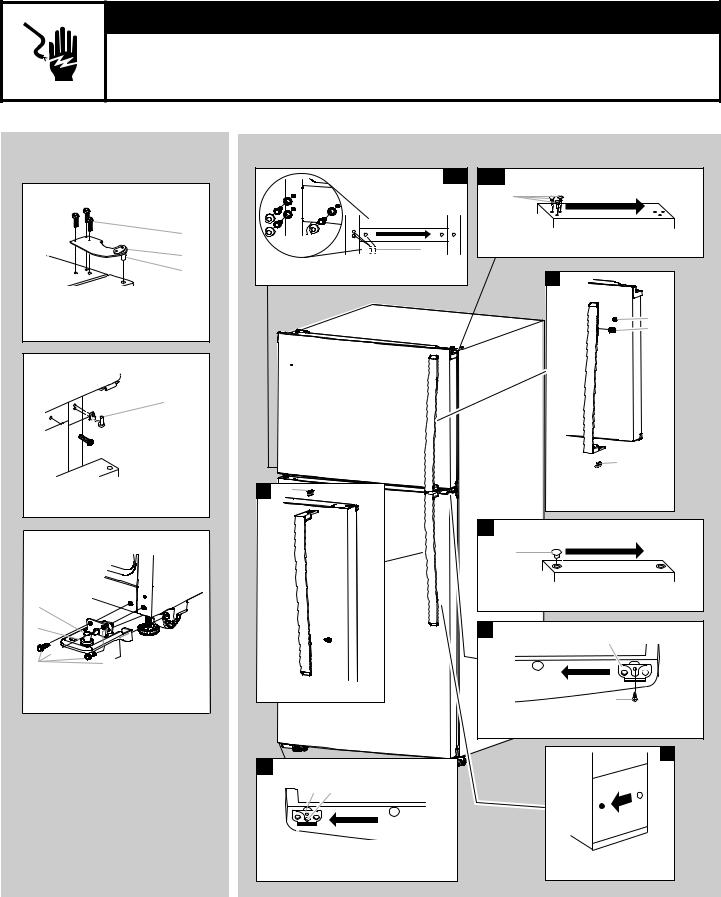
Style 1 – Contour Door
 WARNING
WARNING
Electrical Shock Hazard
Disconnect power before removing doors.
Failure to do so can result in death or electrical shock.
Door Removal &
Replacement
Top Hinge
A
B
C
A.5/16" Hex-Head Hinge Screw
B.Top Hinge
C.Hinge Pin
Door Swing Reversal (optional) |
|
1-1 |
1-2 |
|
A |
A |
A. Cabinet Hinge Hole Plugs |
|
|
A. 5/16" Hex-Head Hinge Screws, |
|
Dome Caps and Dome Cap Washers |
2 |
|
A |
|
B |
Center Hinge
A


 B
B
A.Center Hinge
B.5/16" Hex-Head Hinge Screws
Bottom Hinge
A
B
C
A.Bottom Hinge
B.Washer
C.5/16" Hex-Head Hinge Screw
|
|
C |
|
|
|
A. Shoulder Screw |
|
6 |
A |
B. Setscrew |
|
C. Flat-Head Handle Screw |
|||
|
|
3
A
A. Door Hinge Hole Plug
4 Removal of Door Stops
A
A. Flat-Head Handle Screw |
B |
|
|
|
|
|
|
A. Door Stop |
|
|
B. Door Stop Screw |
5 Re-installation of Door Stops |
7 |
|
|
||
A |
B |
|
A. Door Stop |
A. Door Handle Hole Cap |
|
B. Door Stop Screw |
||
10

Style 2 – Standard Doors |
|
|
|
Door Removal & |
|
Door Swing Reversal (optional) |
|
|
|
|
|
Replacement |
|
1-2 |
1-1 |
Top Hinge |
|
A |
|
|
|
|
|
A |
|
A. Cabinet Hinge Hole Plugs |
|
B |
2 |
|
|
|
|
A |
|
C |
|
D |
A. 5/16" Hex-Head Hinge Screws, |
|
Dome Caps and Dome Cap Washers |
||

 A C
A C


 B
B
A.Top Hinge Cover
B.5/16" Hex-Head Hinge Screw
C. Top Hinge
Center Hinge
A


 B
B
A.Center Hinge
B.5/16" Hex-Head Hinge Screws
Bottom Hinge
A
B
CA. Bottom Hinge
B.Washer
C.5/16" Hex-Head Hinge Screw
C
 C
C
A. Shoulder Screw
B. Setscrew
C. Flat-Head Handle Screw
D. Screw Cover
3 |
A |
A. Door Hinge Hole Plugs |
4 |
A |
A. Door Handle Sealing Screws |
Front View |
|
Side View |
5 |
6 |
A |
A. Door Stop Screw |
A |
B |
|
|
|
B. Door Stop |
|
|
|
|
|
7 |
A. Door Handle |
Hole Cap |
A
A

 B
B
A.Flat-Head Handle Screw
B.Screw Cover
11

Reversibility Kit Instructions
If your model came with a Reversibility kit, please use the Brand Badge Placement template and the following instructions to install the Brand Badge on the opposite side of the freezer door.
Parts Included:
Brand badge removal tool
Brand badge template (on last page of User Instructions) Door handle hole cap
Tools Needed:
Scissors Masking tape
Freezer Door
1.Using the removal tool (provided), remove the brand badge from the freezer door by lifting up the right-hand side and peeling the badge away from the door from right to left.
NOTE: To avoid scratching the door, do not use a sharp or metallic object to pry the brand badge from the door.
2.Rub a small amount of liquid dish soap over any adhesive residue with your fingers. Rinse the door with warm water and dry with a soft cloth.
3.Cut the template along the dotted lines that match the shape of the brand badge.
4.Align the edges of the template with the side and top of the freezer door and tape the template to the door.
NOTE: When the template is correctly aligned, the hole in the door, where the handle was, will be within the cutout of the template, as shown.
5.Using the cutout as a guide, press the brand badge onto the freezer door making sure that the hole is completely covered.
6.Slowly remove the template.
Adjust the Doors
IMPORTANT: Your refrigerator complies with American Disabilities Act (ADA) guidelines.
Door Closing
Your refrigerator has two front adjustable levelers - one on the right and one on the left. To avoid a hazard due to instability, if your refrigerator seems unsteady or you want the doors to close easier, adjust the refrigerator's tilt using the following instructions:
1.Turn the leveler to lower or raise that side of the refrigerator. It may take several turns to adjust the tilt of the refrigerator.
■■ To raise, turn the leveler to the right.
■■ To lower, turn the leveler to the left.
NOTE: Having someone push against the top of the refrigerator takes some weight off the levelers and rollers which makes it easier to adjust.
2.Open both doors again to make sure they close as easily as you like. If not, tilt the refrigerator slightly more to the rear by turning both leveling legs to the left; it may take several more turns.
NOTE: To keep the refrigerator level, you should turn both leveling legs the same amount.
3.Using a level, be sure that the refrigerator is still level side to side. Readjust if necessary.
Door Aligning
If the space between your doors looks uneven, you can adjust it using the following instructions:
1.Depending on your model, remove the Top Hinge cover.
2.Loosen the top hinge screws using a 5⁄16" socket or wrench.
3.Have someone hold the door in place or put a spacer between the doors while you tighten the top hinge screws.
4.Replace the Top Hinge cover, if removed in Step 1.
12
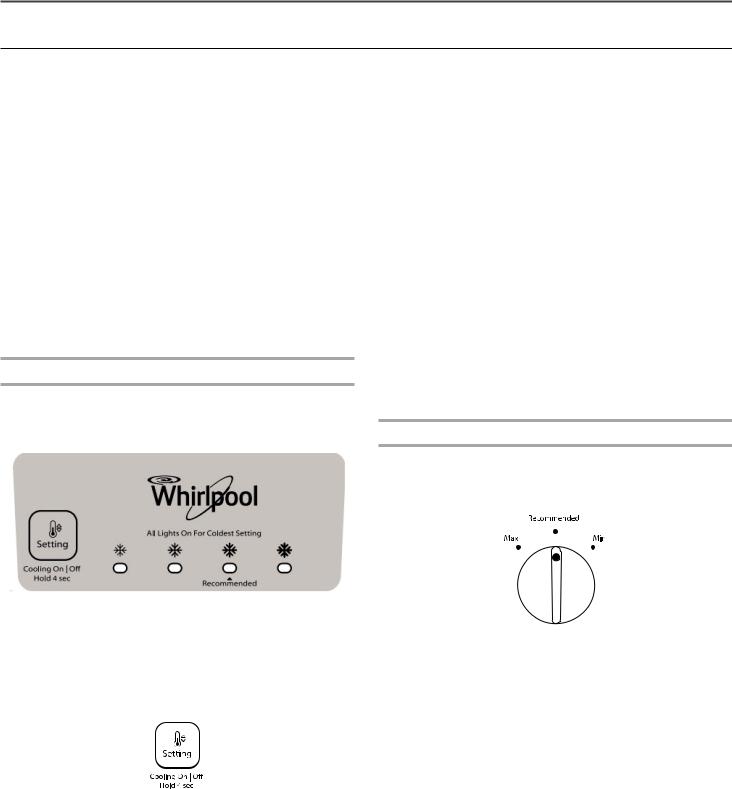
REFRIGERATOR USE
Using the Controls
Your refrigerator has two controls that affect the temperature. The Temperature control located at the top front of the refrigerator compartment and the Airflow control located on the back wall of the freezer compartment.
IMPORTANT:
■■ The recommended setting should be correct for normal household refrigerator use. The controls are set correctly when milk or juice is as cold as you like and when ice cream is firm.
■■ Wait 24 hours for your refrigerator to cool completely before adding food. If you add food before the refrigerator has cooled completely, your food may spoil.
NOTE: Adjusting the refrigerator and freezer temperature controls to a colder than recommended setting will not cool the compartments any faster.
■■ If the temperature is too warm or too cold in the refrigerator or freezer, first check the air vents to be sure they are not blocked before adjusting the controls.
Temperature Control
For your convenience, the Temperature control is preset at the factory. When you first install your refrigerator, make sure the control is still preset as shown.
Recommended Setting
Cooling Off/On
■■ To turn cooling off, press and hold the Setting button for 4 seconds until all lights are illuminated for 1 second. To turn cooling back on, press and hold the Setting button again for 4 seconds.
NOTE: Neither compartment will cool when the control is set to OFF.
Adjusting the Temperature Control
If you need to adjust the temperature in either the refrigerator or freezer compartment, use the settings listed in the chart below as a guide.
NOTE: Except when starting the refrigerator, do not adjust the control more than one setting at a time. Wait 24 hours between adjustments for the temperature to stabilize.
■■ Press the SETTING button to toggle among the 4 LED lights which indicate the temperature setting. Reading from left to right, the LED in the first position is the least cold. The LEDs indicate increasingly colder settings as you continue to the right until all 4 LEDs are illuminated.
CONDITION/REASON: |
ADJUSTMENT: |
REFRIGERATOR too warm |
TEMPERATURE control one |
|
setting higher |
|
|
FREEZER too warm/Too little |
AIRFLOW or TEMPERATURE |
ice |
control one setting higher |
|
|
REFRIGERATOR too cold |
TEMPERATURE control one |
|
setting lower |
|
|
FREEZER too cold |
AIRFLOW or TEMPERATURE |
|
control one setting lower |
Airflow Control
The Airflow control regulates the amount of air flowing between the freezer and the refrigerator compartments.
When you plug in the refrigerator for the first time, turn the Airflow control to the Recommended setting.
Adjusting the Airflow Control
If you want to temporarily increase the cold airflow to a specific compartment, adjust the control.
■■ Max - Increase airflow to the freezer.
■■ Min - Increase airflow to the refrigerator.
IMPORTANT: Once the performance is achieved, return the Airflow control to the Recommended setting to keep the refrigerator operating at optimum efficiency.
CONDITION/REASON: |
ADJUSTMENT: |
Heavy ice use |
Max |
|
|
Hot room temperature |
Max - to maintain ice making |
|
production rate |
|
|
Large quantity of groceries |
Min - to quickly chill food and |
|
beverages |
13
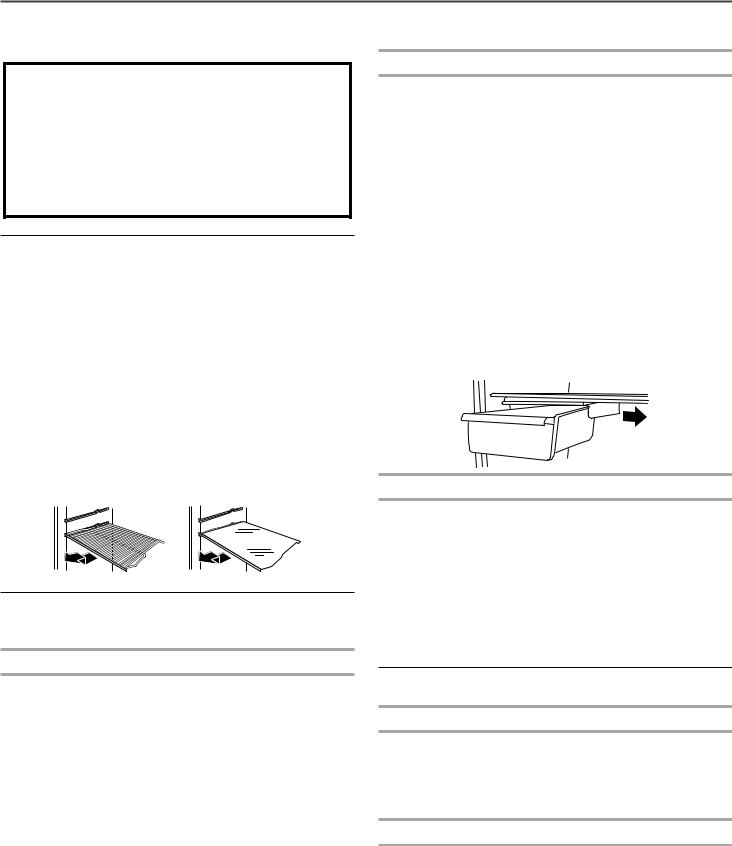
REFRIGERATOR FEATURES
Your model may have some or all of these features.
Important information to know about glass shelves and covers:
Do not clean glass shelves or covers with warm water when they are cold. Shelves and covers may break if exposed to sudden temperature changes or impact, such as bumping. Tempered glass is designed to shatter into many small, pebble-size pieces. This is normal. Glass shelves and covers are heavy. Use both hands when removing them to avoid dropping.
Refrigerator Shelves
The shelves in your refrigerator are adjustable to match your individual storage needs.
Storing similar food items together in your refrigerator and adjusting the shelves to fit different heights of items will make finding the exact item you want easier. It will also reduce the amount of time the refrigerator door is open, and save energy.
To remove and replace a shelf:
1.Remove items from the shelf.
2.Slide the shelf straight out to the stop.
3.Depending on your model, lift back or front of the shelf past the stop. Slide shelf out the rest of the way.
4.Replace the shelf by sliding the back of the shelf into the track in the wall of the cabinet.
5.Guide the front of the shelf into the shelf track. Be sure to slide the shelf in all the way.
Deli Drawer
The deli drawer design allows flexible positioning.
Deli Drawer
To reposition the deli drawer:
1.Remove deli drawer.
2.Release cover and place it between the desired crossbars.
3.Secure the rear clips onto the shelf.
4.Replace the deli drawer.
To remove and replace the deli drawer:
1.Slide deli drawer out to the stop.
2.Lift front of deli drawer with one hand while supporting bottom of drawer with other hand. Slide drawer out the rest of the way.
3.Replace the drawer by sliding it back in fully past the drawer stop.
Deli Drawer Cover
To remove and replace the deli drawer cover:
Style 1 - Wire Shelves
1.Remove the deli drawer.
2.Push the cover back to release the rear clips from the shelf. Tilt the cover up at the front, and then pull it forward.
3.Replace the deli drawer cover by fitting the notches and clips on the cover over the rear and center crossbars on the shelf.
4.Replace the deli drawer.
Style 2 - Glass Shelves
1.Remove the deli drawer.
2.Remove items from the shelf.
3.Slide the shelf straight out to the stop.
4.Slide the deli cover to one side until free.
5.Insert the cover into the shelf tracks.
6.Slide the shelf back into the refrigerator, and then replace the deli drawer.
NOTE: The deli drawer slides sideways on the shelf to allow for flexible positioning.
Meat Storage Guide
Store most meat in original wrapping as long as it is airtight and moisture-proof. Rewrap if necessary. See the following chart for storage times. When storing meat longer than the times given, freeze the meat.
Fresh fish or shellfish......................... |
Use same day as purchased. |
|
Chicken, ground beef, variety meats (liver) |
...................... 1-2 days |
|
Cold cuts, steaks/roasts .................................................. |
|
3-5 days |
Cured meats.................................................................... |
|
7-10 days |
Leftovers - Cover leftovers with plastic wrap, aluminum foil, or plastic containers with tight lids.
Crisper
Crisper Drawers
To remove and replace the crisper drawer:
1.Slide the crisper drawer straight out to the stop. Lift the front and slide the drawer out the rest of the way.
2.Replace the drawer by sliding the drawer in fully past the stop.
Crisper Cover
To remove and replace the crisper cover:
1.Remove the crisper(s).
2.Pull the glass straight out.
14
